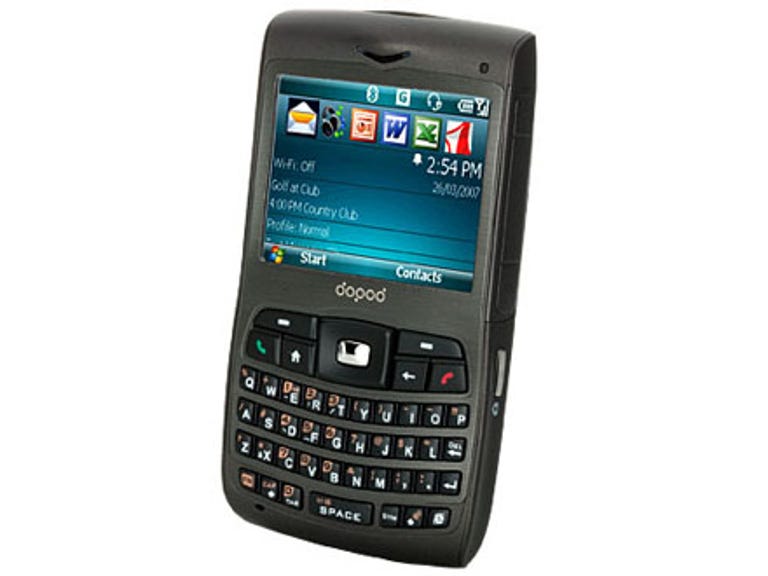 Why You Can Trust CNET
Why You Can Trust CNET Dopod C730 review: Dopod C730
Dopod's C730 has some great and highly enticing technology hiding under its slim hood. A pity then, that it's such a poor smartphone to actually use.
Design
It's a testament to the success of RIM's Blackberry that we can describe an entire subset of mobile phones as being "Blackberry clones". The C730 is yet another entry in the category, and in the important design stakes it does quite well. There are few surprises; a tiny thumb-operable keyboard beneath a five way selector and a 2.4 inch display screen. The right hand side of the C730 houses a touch-sensitive panel that acts as a virtual scroll wheel, Blackberry style. There's no touchscreen to deal with (and thus no stylus). The C730 is nicely slim for a smartphone in this category at only 13.5mm thick, although like the rest of its kin, it's still a physically large phone that won't suit every pocket.
The Good
The Bad
The Bottom Line
Features
The C730's core specifications read like a who's who of desirable tech acryonyms, at least for the geeky crowd. It's a 3G phone with HSDPA support, along with 802.11g and Bluetooth wireless, Windows Mobile 6, HTML mail support, and 2.0 megapixel camera, all running on a 400MHz Samsung processor with 64MB of RAM and 128MB of RAM. Simply put, the C730 can be put to pretty much any business task (and even a few less enterprise-centric functions) -- but does it do them well?
Performance
Sadly, the answer to that question is "no".
It's not that the C730 doesn't try hard or that the core technology underlying it isn't capable -- in fact, the C730 is undeniably a technically very attractive phone. It's simply that it's hampered by some very poor interface and control decisions that make using this particular smartphone far more annoying than it really should be -- and critically, more annoying than competing models from other manufacturers.
For a start, the main keyboard is very small indeed, with very indistinct buttons. That's a flaw that a number of this type of smartphones have suffered from. Combine that with the flimsy-feeling directional controller and things get worse. Where the C730 really falls over, however, is the control strip that forms a virtual scroll wheel on the side. We get what Dopod/HTC were going for with the control strip -- there's no shortage of people who dislike RIM's move to "Pearl" trackballs for its consumer Blackberry models and long for models with side-mounted scroll wheels. The problem that the C730 has is that people long for the scroll wheels because they work, and work well, but the C730's virtual version doesn't. It's twitchy, hard to accurately control and far too prone to accidentally activating itself when you're just holding the phone, turning your attempts to launch messenger into an accidental phone call to your boss, who then hears nothing but you swearing at your phone for a couple of minutes until you realise the problem.
The lack of a touchscreen on an icon-driven interface has also led the C730 into a curious position, where some menu items can either be scrolled directly with the virtual strip (if you're very patient) or the directional pad (if you're not), or skipped with a number press. While you're still learning the layout, however, it's difficult to work out which works better -- and arguably none of them do.
There are other less troubling problems with the C730, although again they're not unique among the Blackberry clone set. The small keys make actual phone dialling quite difficult. This isn't a problem for dialling contacts, but we struggled with inputting new numbers, and we'd hate to have to dial anything in a hurry or after a few swift ales.
The 2.0 megapixel camera is looking distinctly quaint against the new guard of 3.2 megapixel equipped camera models. There's no secondary camera, either, which puts 3G video calling out of the equation. There's also no GPS functionality, or headphone socket either -- you'll either need a USB or Bluetooth Stereo headset to take advantage of the inbuilt Media Player 10 Mobile software.
Ultimately, the C730 is something of a case study in how to take great and interesting technology and then make it irrelevant through poor interface design.


